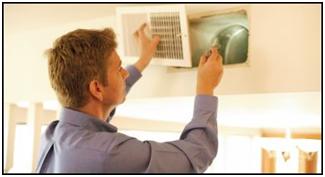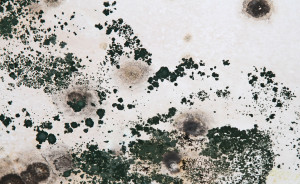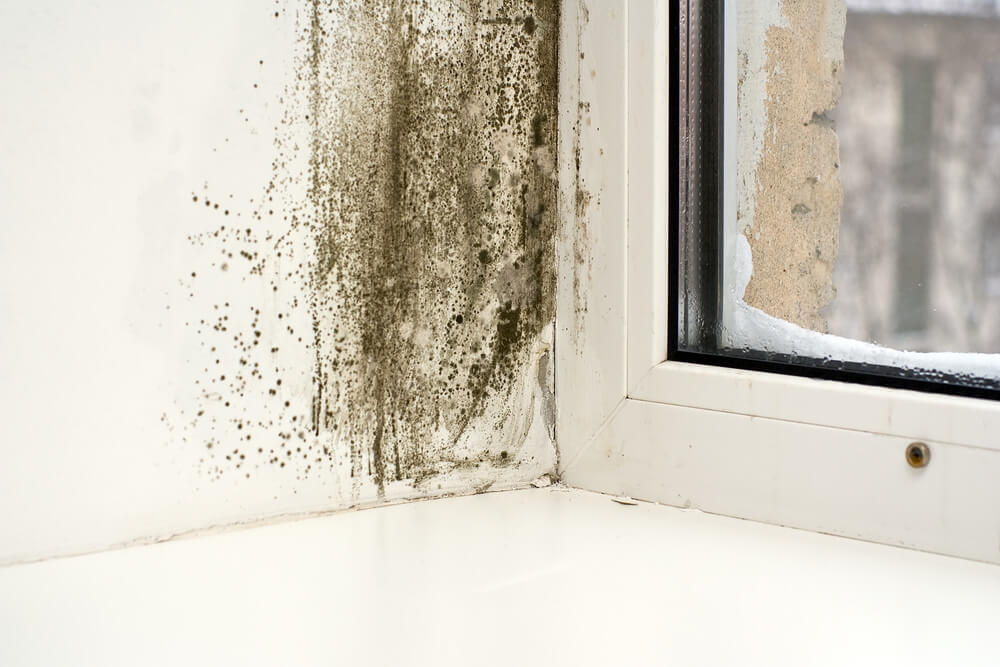Mold
Molds are simple, microscopic organisms that can grow virtually anywhere, both in homes and outdoors. Along with mushrooms, yeasts, and mildew, molds are classified as fungi. Molds typically consist of a network of threadlike filaments that infiltrate the surface on which the mold is growing. Molds reproduce by releasing spores, which are lightweight and small enough to travel through the air. Spores can resist dry, adverse environmental conditions, allowing them to outlive the mold that produced them.
Mold growth often appears as a green, gray, black, brown, or other discoloration on a surface. Eventually, mold growth results in the breakdown of the substrate. More than 1,000 types of molds have been found in U.S. homes.
Sources of Mold
Molds play an important ecological role in breaking down dead organic matter and returning nutrients to the environment. They require moisture and food to grow, and they typically thrive in warm, moist environments. Moisture is the key factor determining mold growth in the home, influencing both the types of mold present and the extent of mold colonization. A variety of materials found in the home, including insulation, wallpaper, glues used to affix carpet, backing paper on drywall, dust, and dirt, can serve as a food source for mold. Mold colonies can go dormant under adverse conditions and revive when favorable conditions return.
Health Impacts
Mold is a serious health hazard in the home environment, as it produces allergens, irritants, and in some cases, potentially toxic substances. Mold can also trigger respiratory problems such as asthma in vulnerable and allergic populations. Therefore, preventing and eliminating mold problems is a crucial part of ensuing quality housing conditions.
People are exposed to mold on a daily basis. Most exposures in the home occur when occupants inhale spores or mold fragments, which are components of household dust. They also may be exposed when their skin comes into contact with mold-contaminated materials.

Mold Removal Specialists
Mold is a natural living organism in the Northeast. It exists in the air in the form of microscopic spores that move in and out of buildings through doors, windows, vents, HVAC systems and anywhere else where air enters the residence. If you suspect you may have a mold problem, it is always best to have a certified mold inspector assess the overall condition of your home. Mold removal measures being outlining is a vital and pertinent way ensure proper remediation techniques are implemented at every jobsite.
Mold Testing & Inspection Process
- Send 2 certified technicians to the property to do a full five point inspection, visual and manual assessment
- Take air samples to check if there is mold in the air, and swab samples to check if there is mold on surfaces. We then check for possible water intrusion points that may lead to mold, and take non-invasive moisture level measurements
- Take photographs of mold specimen sources and attach them to a “Chain of Custody” document; a procedure compliant with legal standards for evidence. Additionally, we use particle counters in and outside your home to determine the amount of negative particles that are in elevated indoor levels as compared to the outside
- Use infrared camera technology to clearly show mold that may be growing behind walls, and moisture readers to detect moisture damage to drywall, insulation and other materials in your property
- Within 2-3 business days, provide you with a detailed report of the lab results. This report will advise on (1) whether there is mold; (2) severity of the mold growth rate; (3) the recommended remediation steps to remove the mold; and (4) instructions to prevent mold from reoccurring along with infrared photos of your property. Mold Removal guidelines are outlined in detail on all reports compiled.
Services Include
- Mold Testing of Surfaces and Air
- Leak Detection and Moisture Testing
- Arsenic and Bacteria Testing
- Volatile Organic Compounds (VOC) Analysis and documentation
- Recommendations for Removal / Remediation ( If Necessary )
- Infrared Thermography (Thermal imaging)
- Expert Witness Testimony
- Energy Audits
- Post-Remediation Testing and Inspections
- Advanced Mold Inspections

Guide to Handling a Mold Claim
It is important to document the conditions causing the mold and any water damage in the property. Often times, landlords and associations will attempt to cover up the evidence and this is why it is important to have photographic evidence of the mold and water damage. Make sure you have copies of the photos and keep them in a safe place. These photographs may be important later on to document the condition of the premises when the mold was first discovered and prior to any remediation work being done.
It is important to have the property tested for mold. all mold inspectors are required to have a speciality mold assessors license. It is very important to hire a licensed mold assessor or inspector who is an expert in mold testing. We recommend having the licensed mold assessor perform an air sample in each room where the presence of mold is suspected. In addition, the mold assessor should take a swab sample of any visible mold to verify the type of mold and the spore concentration
If the landlord or association isn’t aware of the mold problem, then they can’t be held responsible for your damages. It is important to notify the landlord or association in writing (by certified mail) as early on as possible. Since it is important that your notice comply with the law in order to succeed in your claim
Just because there is mold where you live doesn’t mean you are automatically entitled to damages. You have to prove to the court that you suffered financial expenses such as: moving expenses, mold testing expenses, damage to your personal property, hotel bills and more. It is important to keep your receipts and keep track of any lost days of work. It is also important to make a list of all of your property that was damaged and locate any receipts showing how much each piece of property cost you to purchase.
If you believe that you are suffering from mold exposure, it is important to go see your doctor. Any medical claim must be supported by expert testimony from a licensed physician. Ideally, it is best to see a physician who has experience with injuries caused by mold exposure. However, it is always a good start to see your regular physician. The category of physicians that often are involved in the assessment of injuries from mold exposure include: allergists, pulmonologists, toxicologists and environmental specialists.

How to interpret your mold air sampling results.
Many have asked me about how to interpret indoor air quality results. Since there is very little to be found regarding mold test results and air sampling interpretation on the web, I have decided to share this information with the world. The following information is unofficial and opinionated in nature and is to be used as a guide to help understand mold concentrations. I have developed this guide through many hundreds of successful mold remediation projects. This guide shall not be considered a final conclusion of mold remediation requirements.
DISCLOSURE: The information contained in this document is unofficial and opinionated in nature and is to be used as a guide to help understand mold concentrations. This guide shall not be considered a final conclusion of mold remediation requirements and does not guarantee end results. Furthermore, this guide shall not be used to anticipate end medical result, always consult with your physician if you are experiencing a medical condition.
The Most Relevant Mold Species:
Penicillium/Aspergillus – The most common mold species to show up in Indoor and outdoor air samples. Most of the hundreds of sub-species are allergenic with only a few that are toxic. This group of species will grow with only the humidity in the air as its water source (even in relatively clean, mold-growth-free, indoor environments). Levels vary based upon activity levels, dustiness, weather conditions, outside air exchange rates, and other factors.
Basidiospores – Basidiospores are extremely common outdoors and originate from fungi in gardens, forests, and woodlands. It is rare for the source of Basidiospores to be indoors. However, Basidiospores may be an indicator of wood decay.
Cladosporium – One of the most commonly found molds outdoors and frequently found growing indoors. Spores from Cladosporium are generally present in outdoor and indoor air, even in relatively clean, mold-growth-free, indoor environments. Levels vary based upon activity levels, weather conditions, dustiness, outside air exchange rates, and other factors.
Curvularia – A common allergenic mold. Curvularia can grow on a wide variety of substrates.
Chaetomium – A common water marker that usually indicates wet paper and/or drywall. Chaetomium growth can be widespread, cellulolytic and very commonly found on damp sheetrock paper.
Stachybotrys – A common water marker and the most common toxic mold species. Stachybotrys is rarely found indoors, but when found, is an indication of a problem. Stachybotrys can be considered elevated at a very low concentration. Stachybotrys is commonly found indoors on wet materials containing cellulose, such as wallboard, jute, wicker, straw baskets, and other paper materials. Stachybotrys are widely considered the most hazardous form of indoor mold and are mycotoxin producing and must be removed. Whenever Stachybotrys are present, air sampling is highly recommended for clearance confirmation
Mold Spore Level Guide:
Identification of an active fungal growth or indoor reservoir can be extremely difficult without scientific testing, also known as scientific confirmation. Swabs, tapes and bulk samples are considered the lowest form of scientific confirmation as it only addresses a small localized area of confirmed mold growth. Swabs, tapes and bulk samples are capable of identifying mold types, but do not indicate the size of a mold contamination due to their localized testing.
Air sampling is considered the highest level of scientific confirmation as it not only confirms the presence of mold spores and types, it also indicates the quantified amount of mold spores in the air. This information can then be interpreted to understand the potential impact to health as mold spores caught in the air can be inhaled into the lungs. Mold spores found in the air are typically viable, meaning if conditions are favorable, they are able to grow.
YOUR SPRING GUIDE TO MOLD AND MILDEW
With spring comes an annual spring cleaning, warm temperatures, and humidity, that is the perfect environment for mold and mildew growth. Here are a few things you should know about mold and mildew during the spring season
Keep an Eye out for Mold Growth
Most mold growth is visible. In most cases, you can see mold developing in your home. Keep this in mind and keep an eye out for dangerous mold growth. If you see a mysterious growth growing on the inside of your walls or ceilings, its most likely mold.
The Difference Between Mold and Mildew
The main visual difference between mold and mildew is the texture. Mildew tends to be more of a powder texture, whereas mold tends to be thick and possibly have a fur-like texture to it. Mold can also come in a variety of colors and can grow in any moist environment. In contrast, Mildew is generally white or gray and grows on most plants or in shower grout.
Mold and Mildew Are Dangerous
If you have mildew or mold growing in your home, it could be a sign of a humidity or moisture level issue. Even something as small as slight mildew in your bathroom could be a sign of an issue that needs further investigation.
Mold Remediation
If you think you might have mold in your home, it is recommended that you have a mold inspection performed. If you are looking to have a mold inspection performed